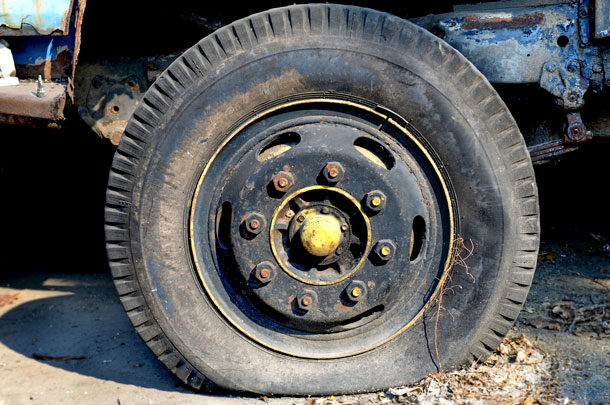I flagged down the driver and told him he had a seriously underinflated trailer tire. He walked back and looked at them, and told me they were okay. I repeated what I observed, suggested that he put a tire pressure gauge on the tires and left him to his soon-to-arrive blowout caused by underinflation overheating.
Not that long ago, I had an eye-opener pertaining to car tire inflation. I own a 1979 Mazda RX-7 sports car, the ’79 being the first year they were available in this country. After moving the seat back so I could shoehorn my oversized carcass behind the wheel, it’s fun to take it through curves.
The car had an issue that took me several months to get to, but I finally took it out for a drive. I had looked at all four tires before I left, and they looked evenly inflated. The car loves curvy, twisting roads – but not this day. The speed posted on the warning signs was about all the speed the car could safely handle. I drove it back home and found the air pressure gauge. As per my visual inspection, the tires were all evenly inflated – at about 19 psi each.
I aired them up to 30 psi and went back on the road. The old RX-7 was back, and I was (don’t tell Momma) sailing through sweeping curves posted for 40 mph at 70, with the little rascal feeling like it was on rails.
The owner’s manual for my pickup tells me that I need 60 psi in the front tires and 80 in the rear. My pickup is used mostly as a mobile office. It has the heavy Cummins engine in the front and only a reserve fuel tank and a toolbox and some hay sampling tools in the back, with occasional small hay samples. I run 72 psi in the front tires and 60 in the rear. Why?
For optimal tire wear, the whole face of the tread needs to be in contact with the pavement. With more than 72 psi in the front tires, the outside edge is not in contact with the pavement. Same with the rear tires if I run them over 60 psi. By running the tires at a pressure that is optimal for the actual weight carried, I’m getting close to 80,000 miles on a set of tires.
The pressures listed in the owner’s manual are a compromise for soft ride and for the rear tires to not overheat when loaded to maximum weight allowed for the truck.
Loader tires seem to be among the most neglected. I’ve seen many loader tires with the pair that bears the loaded weight of a filled bucket lacking the air they need. The operator won’t notice this, because he can’t see the tire while operating the loader.
When a tire on a loader or other farm implement shows cracks in the sidewall, running from the bead toward the outside tread, it’s a sure bet that tire has been operated most of its life underinflated.
On the road, properly inflated tires can easily add 10 percent to your fuel mileage and 50 percent to tire life. It’s important enough that the newer highway trucks have airlines running from each tire so that the truck’s air brake air pressure will keep all the tires fully inflated.
An underinflated tire squishes as it goes down the road. This causes the tread to meet the pavement rather soft and gushy, which makes it begin to wear irregularly. It also causes a tremendous amount of heat. The remains of blown-out tires sometimes seen on the highway are not “thrown recaps,” but are tires that have overheated and disintegrated.
Once a tire starts wearing with dips and divots in the tread surface, it’s almost impossible to bring it back.
Air pressure should be checked when the tires are cold. The heat of a hot day, hot road, fast driving and heavy load will raise the air pressure.
When traveling, even just a trip to the store, at least look at each of your tires. If you’re on a longer trip, it’s a good idea to place your hand on the tread surface of each tire and note whether they are all the same temperature.
All tires need to flex. Too much flexing causes heat, and that melts rubber, and melted rubber in a tire causes undesirable loud noises and loss of control of the vehicle you are driving. ![]()

-
Brad Nelson
- Freelance Writer
- Royal City, Washington
PHOTO: Photo provided by Thinkstock.













